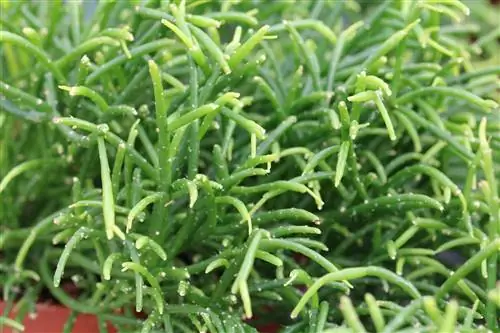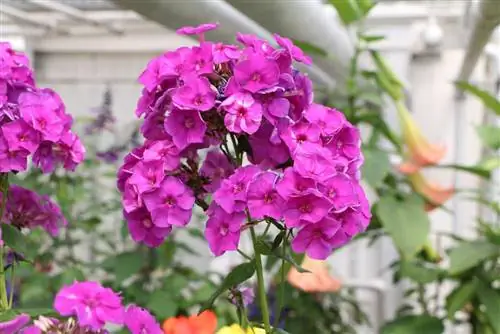- Author admin [email protected].
- Public 2023-12-17 03:39.
- Last modified 2025-01-24 12:45.
Rhipsalis cereuscula is a type of cactus and is also colloquially known as coral cactus. The cactus is native to South America and grows primarily in Argentina, Bolivia and Brazil. Due to its tropical origins, it is not hardy. Rhipsalis cereuscula is only suitable for indoor cultivation all year round, but can spend the summer in a protected location outdoors when temperatures are warm. The cactus grows epiphytically, which means that it grows sitting on a tree; its shoots can be up to 60 cm long.
Location & plant substrate
Rhipsalis cereuscula needs a bright location and a loose substrate so that it does not get waterlogged. The plant should not be placed too close to the window to avoid being burned by the sun. With a little distance from the window, it can also withstand summer midday heat. Over the summer, the cactus can be moved to a partially shaded to sunny spot on the balcony, terrace or in the garden.
If the temperatures worsen, it should move back into the living room. In addition, Rhipsalis cereuscula must be accustomed very slowly to the direct sun, which is no longer filtered through the window. The following aspects must be taken into account regarding the site conditions and the planting substrate:
- sunny to partially shaded location
- Sunlight is optimal in the morning, in the evening and all day in winter
- Bright midday sun is not tolerated
- permeable plant substrate with sand content
- Commercial cactus soil containing pumice gravel, pine bark and clay granules is ideal
- Does not tolerate cold soil
Tip:
The gardener can also make the substrate for the cactus themselves. To do this, mix two parts of peat-free vegetable or herb soil with one part of bird sand and one part of pumice gravel or clay granules.
Temperature & Humidity
The Rhipsalis cereuscula thrives in rooms with normal temperatures if the room temperature remains consistently high all year round. In addition, a slightly increased humidity is beneficial for improving growth:
- cultivate all year round at room temperature
- prefers high humidity
- place containers with water in the room to increase the humidity
- Spray with water mist every now and then, but not too often
Watering & Fertilizing
Rhipsalis cereuscula, in contrast to its relatives living in steppe and desert areas, requires significantly more water. The frequency of casting units depends on various environmental factors. During the hot summer, the plant's water requirements are significantly higher than in a cool location in winter. In addition, a large specimen with many shoots requires much more fluid than a young cactus. The plant substrate must never dry out completely, as this has harmful effects on the cactus. After purchasing, there is no need to fertilize in the first year because the ready-made substrates have already been fertilized in advance. The same fact also applies after repotting, as the clay granules and soil mixtures for cacti contain fertilizer. If you forget to fertilize every now and then, this will not harm the Rhipsalis cereuscula. The following criteria must be observed when watering and fertilizing:
- water abundantly during the growing season (spring to summer)
- Let the substrate dry out almost but not completely between waterings
- the smaller the pot, the more often you water it
- water moderately in winter at normal room temperatures
- extremely sensitive to limescale, only use soft water
- pure rainwater is ideal
- Waterlogging is not tolerated at all
- fertilize from April to September
- Fertilizers for vegetables, green plants, cacti and orchids are optimal
- Administer fertilizer once a month
- In order to support the increased formation of buds, fertilize every 2 weeks
- After opening the buds, stop fertilizing completely
Tip:
If the tap water is very calcareous and there is no possibility of collecting rainwater, the water from the tap should be softened using a special water filter.
Repotting
If the planter has become too small, it will need to be repotted. Since the cactus species only develops a few and very small roots, this process is rarely necessary. Ideally, the Rhipsalis cereuscula should be repotted during the growing season and not during the winter. The following procedure should be followed when repotting:
- The time from spring to autumn is ideal for repotting
- Carefully remove the cactus from the pot and clean it carefully
- Add fresh soil into the new planter as needed and insert the cactus
Shoots & flowers
Rhipsalis cereuscula produces long shoots and is therefore ideal as an ampel plant. The flowers of these leaf cacti are quite small, but very pretty, but they only last a few days on the plant. After the flowering period, small, whitish fruits form, with a berry-like shape, which remain on the cactus for several weeks:
- light green and slender shoots, cylindrical shape
- branche at the end and form numerous side branches
- short bristles occasionally form in the area of the areoles, shoots and branches
- greenish white flowers emerge from the areoles, at the tip of the shorter side branches
- star-shaped flowers are produced in large numbers, with a quite strong scent
- Flowering time is in early spring, with good care it can bloom later
Wintering
The Rhipsalis cereuscula can be cultivated all year round at room temperature or kept cool over the winter. If the plant overwinters, this phase has a positive effect on the abundance of flowers and growth:
- overwinter at approx. 15° C, in a location without direct midday sun
- Corridors, attics, unused guest rooms are ideal
Propagate
The leaf cacti are best propagated by cuttings in the warm season. The ideal solution is to grow it in a special cultivation pot that should never be exposed to the blazing midday sun:
- ideal time for propagation is from spring to summer
- optimal temperature values are between 20-28 °C
- cut off a he althy shoot about 8-15 cm long
- Cuttings can be planted immediately after cutting
- use substrate recommended for cacti
- Insert cuttings in small groups of a few specimens into the cultivation pot, approx. 3-4 cm deep
- keep the plant substrate only slightly moist for the following 3-4 weeks
- After root formation, the young plants can be cared for like adult specimens
Diseases & Pests
With incorrect care and unsuitable location conditions, Rhipsalis cereuscula often tends to develop the following diseases and pests:
- Infestation with mites, mealybugs and mealybugs possible
- Mealybugs form as small, white webs that resemble cotton balls
- Check cacti regularly for pests
- Infestation can be easily recognized on the leaves and shoots of the affected plants
- Root rot occurs when watering too much
- Constantly moist soil and insufficiently drained soil are bad
Conclusion of the editors
Rhipsalis cereuscula is ideal for indoor cultivation and is a perfect hanging plant as the shoots can droop far down over time. The cactus is relatively easy to care for and can easily be propagated using cuttings. Due to its tropical origins, Rhipsalis cereuscula is not hardy, but enjoys cooler winter quarters in living spaces. Following the winter period, the cactus will bloom more profusely and grow more vigorously. During the flowering period in spring, the plant produces star-shaped flowers, which have an intense scent and are a beautiful ornament. Important location factors are avoiding midday heat and waterlogging so that Rhipsalis cereuscula can develop he althily.
What you should know about Rhipsals cereuscula soon
Rhipsalis cereuscula is the best-known representative of this cactus species. The plant produces slender, cylindrical, light green shoots. These branch out at the ends and also form numerous side branches. Short spines can occasionally form in the areoles and also on the surface. The flowers form at the tips of the short side branches, from the areoles. Rhipsalis cereuscula is medium in size. When growing, the trunk and branches tend to develop deeper. It is a good hanging plant that comes from South America.
Location
- Rhipsalis cereuscula needs a bright location. However, it cannot tolerate the midday sun.
- The plant can be placed outside in summer - protected from the midday sun.
- The cactus tolerates morning and evening sun well. The place should also be protected from wind and rain.
- In winter the plants also like to stay warm.
- They do not need to be kept cool over the winter to produce flowers. Temperatures between 16 and 20 °C are ideal.
- It is important to limit watering. The cooler the plants are overwintered, the less they water.
- At around 5 °C you stop watering completely.
Planting substrate
- It is important that the plant substrate is well drained. Excess water must be able to drain away easily.
- Peaty, sandy soil is ideal. It should be soft.
Pouring
- Like all cacti, Rhipsalis cereuscula doesn't need much water.
- You always wait until the plant substrate has dried thoroughly before watering.
- However, the plant ball should not dry out completely, although that is better than if the plant is too wet.
- If the bale is dry, it is best to dip it in plenty of water so that it can soak up properly.
- Excess water should be poured off about 10 to 20 minutes after watering, as standing moisture is usually fatal for the plant.
- The roots then rot and the rhipsalis can no longer be saved. The plants can store water inside.
- If the plant is too dry, you can tell by the dry and dry-looking branches.
- Rhipsalis cereuscula like high humidity. You should place containers with water in the room to increase the humidity.
- Spraying the plants regularly is not recommended.
Fertilize
- The plants are fertilized with cactus fertilizer. Fertilize every 14 days to once a month, from spring until bud formation.
- As soon as some of the buds have opened, stop fertilizing.
Cut
- Rhipsalis cereuscula can be trimmed if necessary.
- Pruning is beneficial if you want the plant to become more lush and bushy.
Propagation
- Rhipsalis cereuscula is propagated via cuttings. The best time for this is summer.
- Stem cuttings are used, which are placed in a mixture of sand and peat in equal parts.
- It's best to always plant several cuttings close together.
- The plant substrate must be kept slightly moist for the first few weeks.
- Later, when roots have formed, the young plants are treated like adult specimens.
Pests and diseases
- Pests include mites, mealybugs and mealybugs.
- Too much watering and the resulting constantly moist soil lead to the appearance of root rot, just like poorly drained soil.






